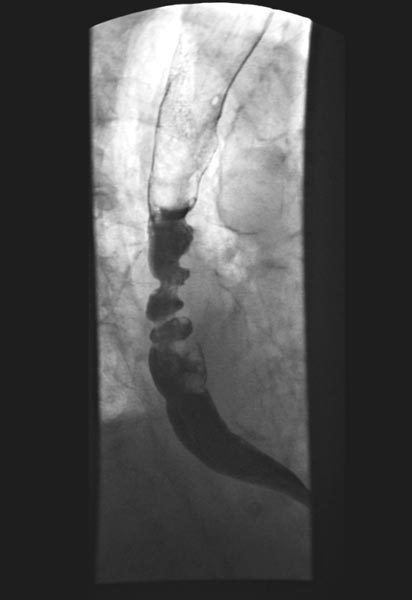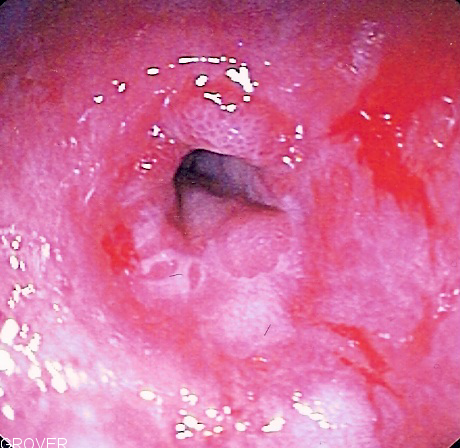Editor-In-Chief: C. Michael Gibson, M.S., M.D. [1] Associate Editor(s)-in-Chief: Parminder Dhingra, M.D. [2]
Overview Esophageal cancer must be differentiated from gastroesophageal reflux disease (GERD), Barrett's esophagus , esophageal achalasia , gastritis , gastric ulcer , and stomach cancer .
Differentiating Esophageal cancer from other Diseases Esophageal adenocarcinoma must be differentiated from other causes of dysphagia, odynophagia and food regurgitation such as GERD, and esophageal stricture.
Manifestations
Diagnostic tools
Achalasia
Dysphagia for solids and liquids is the most common feature, being seen in 91 % and 85% of patients respectively[2] Regurgitation of undigested food occurs in 76-91% of patients[2] Cough mainly when lying down in 30%[2]
Esophagogastroduodenoscopy findings include a dilated esophagus with residual food fragments, normal mucosa and occasionally candidiasis (due to the prolonged stasis).
Barium swallow shows the characteristic bird's beak appearance. Barium swallow showing bird's beak appearance - By Farnoosh Farrokhi, Michael F. Vaezi. - Idiopathic (primary) achalasia. Orphanet Journal of Rare Diseases 2007, 2:38(http://www.pubmedcentral.nih.gov/articlerender.fcgi?artid=2040141 ), CC BY 2.0, https://commons.wikimedia.org/w/index.php?curid=2950922
GERD
Retrosternal burning chest pain.
Cough and hoarseness of voice.
May present with complications such as strictures and dysphagia.
Upper GI endoscopy shows the complications such as esophagitis and barret esophagus.
Esophageal manometry may show decreased tone of the lower esophageal sphincter.
24-hour esophageal pH monitoring may be done to confirm the diagnosis. Barret's esophagus - By Samir धर्म - taken from patient with permission to place in public domain, Copyrighted free use, https://commons.wikimedia.org/w/index.php?curid=1595945
Esophageal carcinoma
Dysphagia Odynophagia - fluids and soft foods are usually tolerated, while hard or bulky substances (such as bread or meat) cause much more difficultyWeight loss Pain , often of a burning nature, may be severe and worsened by swallowing, and can be spasmodic in characterNausea and vomiting
Upper GI endoscopy and esophageal biopsy the gold standard for the diagnosis of esophageal CC BY-SA 3.0, https://commons.wikimedia.org/w/index.php?curid=2587715
Corckscrew esophagus
Retrosternal chest pain that presents with or without food intake.
The condition is not progressive and not causing complications.
Barium swallow shows the characteristic corckscrew appearance of the esophagus. Corckscrew esophagus - Case courtesy of Radswiki, Radiopaedia.org, rID: 11680
Esophageal stricture
Patient may present with the symptoms of the underlying GERD.
Dysphagia and odynophagia.
Barium esophagography provides information about the site and the diameter of the stricture before the endoscopic intervention. Peptic stricture - By Samir धर्म - From en.wikipedia.org, Public Domain, https://commons.wikimedia.org/w/index.php?curid=1931423
References Template:WikiDoc Sources




